Domain Rating vs Domain Authority
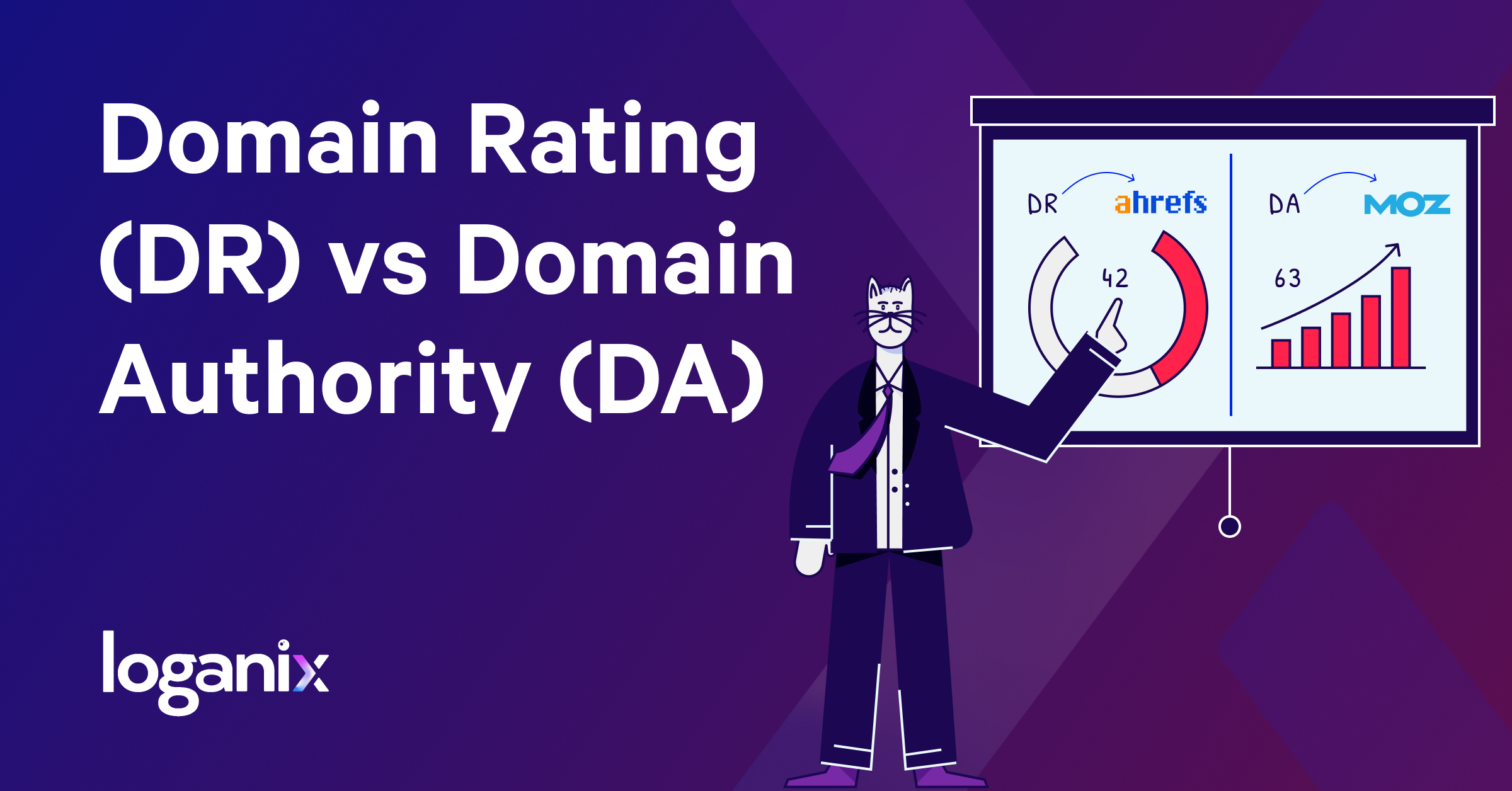
Hand off the toughest tasks in SEO, PPC, and content without compromising quality
Explore ServicesDomain Authority (DA) and Domain Rating (DR) are two of the most prominent metrics that SEOs use to understand website authority.
But when it comes to Dr vs DA, which is the best?
And questions don’t end there:
- What’s the difference between Domain Rating and Domain Authority?
- What’s the relevance of DR/DA to SEO?
- Where and how can you check your site’s authority scores?
- Which metric is superior?
- How do SEO tools calculate your scores?
Thankfully, here are all the answers…..
Domain Rating vs Domain Authority (Quick Answer)
In essence, Domain Rating is a proprietary ranking factor that was developed by Ahrefs to gauge the depth of your web page’s backlink profile, based on an index of 1 to 100.
A high Domain Rating score means that your web page has a solid backlink framework, while a low one translates to a poor profile of inbound links.
Domain Authority, on the other hand, is a logarithmic representation of your site’s potential search engine ranking when compared to other domains in the same niche. You can think of it as a comparative indicator that computes your relative SERP ranking performance on a scale of 1-100.
So, a high Domain Authority score means that you’d probably rank well against your close competitors on the search engine result pages.
What Are The Differences Between Domain Rating and Domain Authority?
Going by everything that we’ve explored regarding Domain Rating vs Domain Authority, the differences between the two can be summed up as follows:
- Domain Rating uncovers the depth of a website’s backlink profile, whereas Domain Authority discloses which site is bound to outrank the rest on SERPs.
- While a Domain Rating score is awarded after reviewing the volume and status of backlinks, Domain Authority takes into account dozens of relevant SEO parameters – including organic traffic patterns, linking root domains, social signals, etc.
- Domain Rating checks are best reserved for backlink-building campaigns, whereas Domain Authority is particularly necessary when you need to identify your competitors and get an idea of the relative SEO strengths.
- Domain Authority is a relative metric that draws comparisons between sites, while Domain Rating tends to be more of an absolute metric.
And with that said, we can now agree that the Domain Rating vs Doman Authority contest ends in a tie.
In other words, neither of these two is superior to the other. You need Domain Rating in your SEO analysis just as much as Domain Authority. They tend to be more impactful when leveraged in tandem.
And while you’re at it, keep in mind that Domain Authority and Domain Rating are only KPIs in the larger SEO ecosystem. To truly get the best out of them, you should follow up your DA and DR analytics with all the relevant search engine optimization tactics.
SERPs are ultimately dominated by the few who manage to tactfully piece together inbound and outbound links with quality content, competitive keywords, exhaustive audits, high converting PPC ads, engaging social media campaigns, etc.
This is the reason why a typical top-ranking page in the SERPs also happens to feature among the top 10 results across nearly 1,000 other relevant keywords.
Loganix has all the formulas, the experience, plus the tools and we’re looking forward to sharing it all with you in your SEO journey. This is one of those exclusive opportunities that you might want to grab before your competitors get wind of it. So, feel free to get in touch with us today to transform your search engine optimization campaigns.
Let’s now dive into the technical details to compare Domain Rating vs Domain Authority:
What is Domain Rating?
Domain Rating, in simple terms, is an abstract of a domain’s backlink profile. Ahrefs came up with the metric to help SEO experts measure the level and strength of backlinks that point to a specific webpage.
DR scores are basically awarded based on the quality and quantity of the backlinks.
You can, for instance, expect the system to review not only the total number of referring domains and backlinks that connect to your website, but also the quality of all the inbound links.
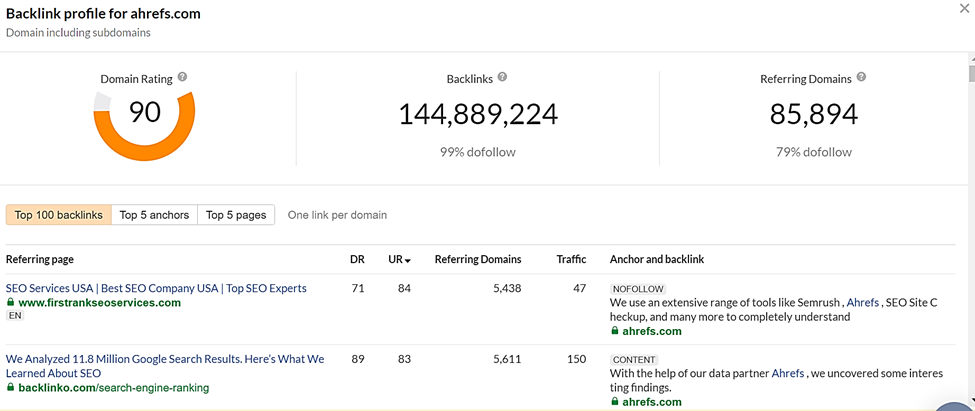
Domain Rating results showing the corresponding backlink profile. Source: Ahrefs
Ok, fair enough. But then that begs the question….
Why is Domain Rating important for SEO?
While Domain Rating is not a search engine ranking factor, the parameters it measures happen to be an integral part of the SERP algorithm.
Google itself openly admits that it continues to prioritize backlinks as one of the principal ranking factors. And to be specific, it takes into account the volume and quality of backlinks pointing to your site, along with the authority of the referring domains.
You’ll find, for instance, that the top ranking sites on the SERPs have, on average, 3.8 times more backlinks than their counterparts on positions two to ten.
As such, you should be able to use your Domain Rating to assess your ranking potential based on the strength of your website’s backlink profile.
And that’s not all. You could also turn to Domain Rating indicators when you’re seeking solid link building opportunities. The trick here is to scan the leading websites in your niche while identifying all the highly influential referring domains that might be open to publishing guest posts.

Look for link building opportunities from the referring page insights. Source: Ahrefs
While you’re at it, remember not to overlook the internal linking opportunities on your own website. It’s possible, for example, to achieve higher scores by simply capitalizing on your internal link juice.
How is Domain Rating calculated?
As the proprietor of the Domain Rating system, Ahrefs maintains not only the core databases, but also the AI engine that handles all the metric analysis and reporting.
So active is the Ahrefs crawler, in fact, that it’s ranked second after Google search.
This has seen the powerhouse build up the most extensive backlink database on the web, boasting 30.3 trillion known links, 262.7 billion indexed pages, and 208 million unique domains.
Ahrefs is not stopping there, though. It continues to crawl through 5.76 billion pages per day while, in the meantime, its backlink index maintains round-the-clock updates at intervals of 15 minutes.
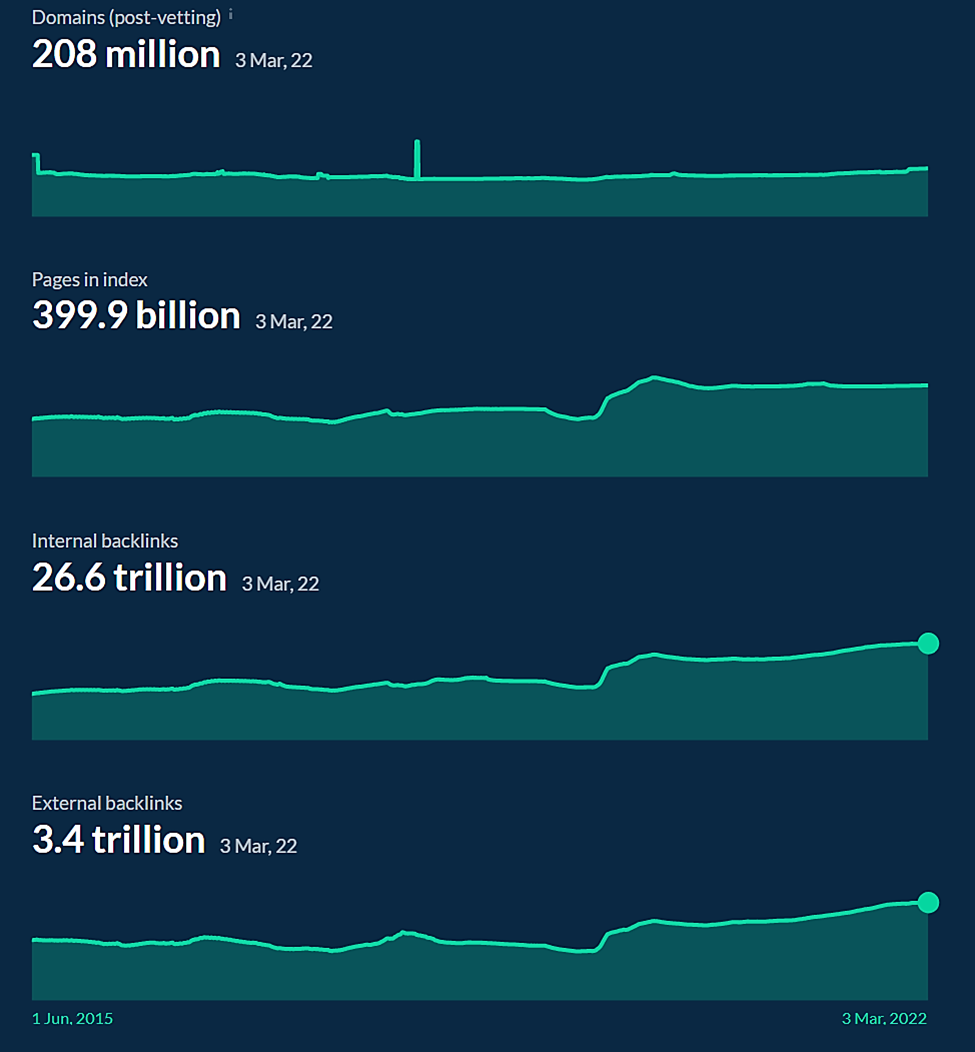
Ahrefs database in size. Source: Ahrefs
Now, with all this data readily available, you can count on Ahrefs to give you a real picture of your backlink situation.
All you need to do is enter your domain or URL and the system will quickly dig into your site data to identify all the relevant nofollow and do-follow links that point towards the subject URL.
The Domain Rating is then worked out based on:
- The total number of unique domains with backlinks to the subject page.
- The total number of backlinks that point towards the subject page.
- The DR scores of those referring domains.
- The number of unique domains that each of the referring sites connects to.
Keep in mind, however, that while Ahrefs always considers the volume of backlinks, quality happens to take precedence over quantity. That means that a site with a handful of high-quality backlinks will easily outshine one with hundreds of low quality links.
The score itself is usually awarded on a logarithmic scale of 1 to 100 – out of which solid link building attracts a high DR of 60 and above, while basic sites average at about 30.
What is Domain Authority?
While the Domain Rating system was developed by Ahrefs, Domain Authority is the brainchild of Moz – a digital marketing tool suite that specializes in SEO, link building, inbound links, and content marketing.
As you’ll come to notice, Moz’s Domain Authority is more of a comparative metric whose score is based on how the subject site measures up against other domains in the same niche. It uses the Moz web index to work out the chances of your domain being featured in the SERPs when compared to its competitors.
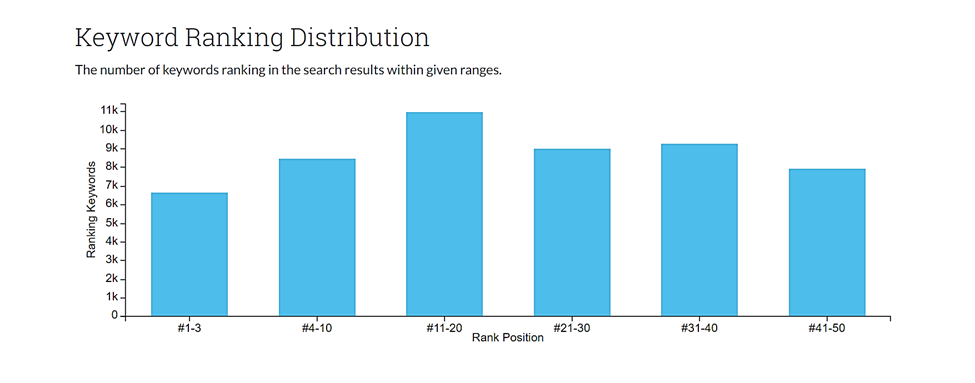
Sample keyword ranking distribution, pulled from a Domain Authority report. Source: Moz
The score comes in the form of a logarithmic scale that ranges between 1 and 100. A low DA score means that your domain has a comparatively low probability of ranking well against its competitors, while a site with a high DA value is expected to perform better in the search engine result pages.
Here’s a word of caution, though. Don’t mistake Domain Authority with Page Authority. Although they are both comparative ranking metrics that review similar parameters, the former deals with domains while the latter analyzes web pages.
You might also want to keep in mind that, just like Domain Rating, the metrics are not part of Google’s ranking factors. They are only meant to make ranking predictions in relation to similar sites
And how is that relevant to SEO?
Why is Domain Authority important for SEO?
The best thing about the Domain Authority score is, it’s established after quantitative and qualitative analysis of the core SEO factors. That means that although DA is restricted to making predictions, at least you’ll be comparing your possible ranking performance based on real SEO parameters.
You can, for instance, use Domain Authority to track how your SEO campaigns are fairing against your close competitor.
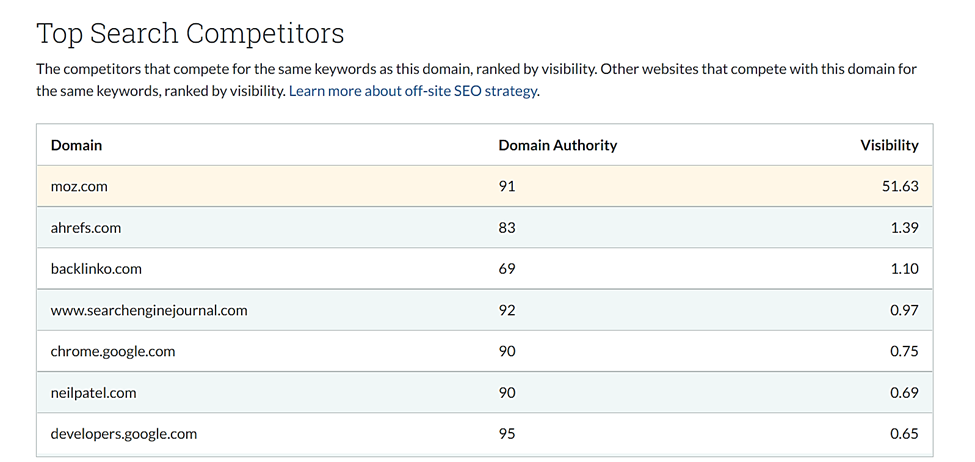
Top search competitors, as identified through Domain Authority analysis. Source: Moz
All you need to do is compare your site’s scores with your competitor’s – as the one with the higher DA value is bound to outrank the other.
And if you happen to perform poorly, you could still rely on Domain Authority to help you catch up with the rest. This is where you gradually optimize your site with impactful SEO tactics – such as content marketing and high-quality external links – while Domain Authority helps you keep tabs on the progress.
How is Domain Authority calculated?
Domain Authority calculations are facilitated by Moz’s own internal machine learning algorithm, which methodically analyses volumes of data pulled from websites indexed by search engines.
The latest version of the AI system, Domain Authority 2.0, was rolled out in 2019 and has since built up quite an expansive live link index.
According to Moz, it now samples data from over 43.8 trillion links, across 8 trillion pages and 743 million domains.
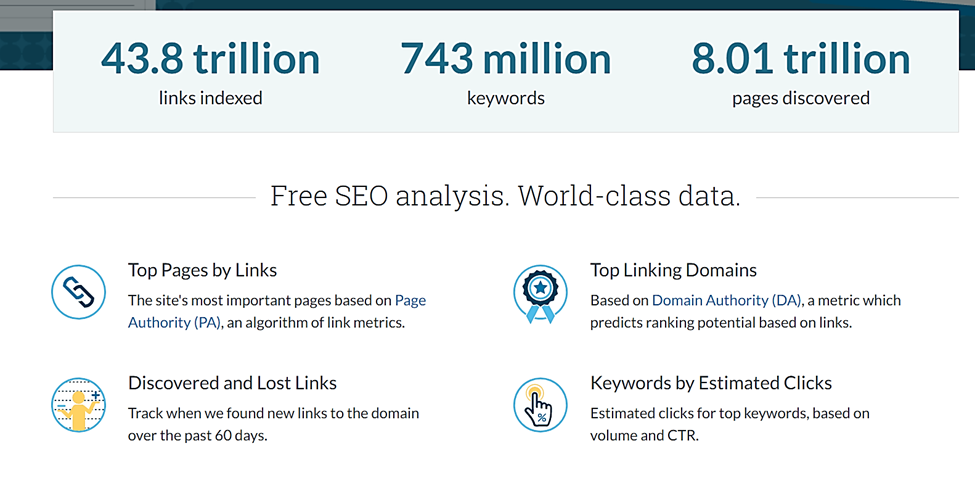
Moz’s database size. Source: Moz
The formula for awarding the domain score is based on 40 different factors, all of which are relevant to SEO. You can think of these as the parameters that collectively make up the criteria for predicting where Google’s PageRank will place your domain in its SERPs.
Some of the known factors include:
- Linking root domains.
- Social media signals.
- Spam score.
- The total number of backlinks (both quantitative and qualitative).
- Website traffic volume.
- The domain age
And so forth.
Basically, Moz extracts all this data from your domain and then correlates it with records from a variety of actual SERP rankings. Hence, the final DA score is determined by how your domain compares with real-world rankings on every single authority metric.
Don’t get it twisted, though. The findings here are not an absolute reflection of your domain’s rankings. Rather, the Domain Authority score should only be treated as an indication of your relative performance, in comparison to other domains in your class.
If you, for instance, manage to register a high score, then it simply means that your domain is ahead of its closest competitors at the time. In that case, your points are bound to drop whenever your competitors’ SEO improvement efforts happen to exceed yours.
Now, to put it into perspective, imagine a high authority domain that scores 75% in the first round. An SEO tweak that would, otherwise, have been worth an extra 2% won’t count for much if the competing domains manage to improve their authority metric by 8% or so.
As a matter of fact, the high authority domain might even end up losing some points in the second round – all because of the reduced relative margin.
How to Check Domain Rating/Authority (3 Methods)
If you ever need to confirm or compare your Domain Rating vs Domain Authority scores, you’ll be pleased to learn that there’s a wide range of DA and DR checkers on the market. A quick Google search alone reveals a vast array of options at different price points.
Unfortunately, however, it turns out that a majority of them are not up to standard in terms of quality and privacy. You can’t really count on their systems to exhaustively conduct DA and DR analysis.
As for the few that have proven otherwise, three DA/DR checkers particularly stand out. Their resilience, accuracy, and reliability have made them favorites among leading SEO experts.
Here are their details, plus tutorials on how you can use the tools to check your Domain Rating/Domain Authority
1. Loganix DA Checker
At the first position is our very own Loganix DA Checker.
We’re not the ones to brag, but there are several reasons the Loganix DA Checker is rated highly by both SEO novices and experienced professionals.
For starters, you’ll notice that while it touts itself as a DA Checker, the analytics here cover much more than just your Domain Authority. Loganix is capable of assessing web pages, competitor sites, and potential link sources on more than 12 relevant SEO metrics.
If, for example, you’re looking to build backlinks to your site, the Loganix DA Checker will help you quickly review any prospective publishing site that you might have in mind.
Apart from the DA score, you’ll be able to figure out other essentials like the site’s citation flow, trust flow, and Domain Rating. The whole system is more like a simplified version of Google PageRank, complete with the most important insights.
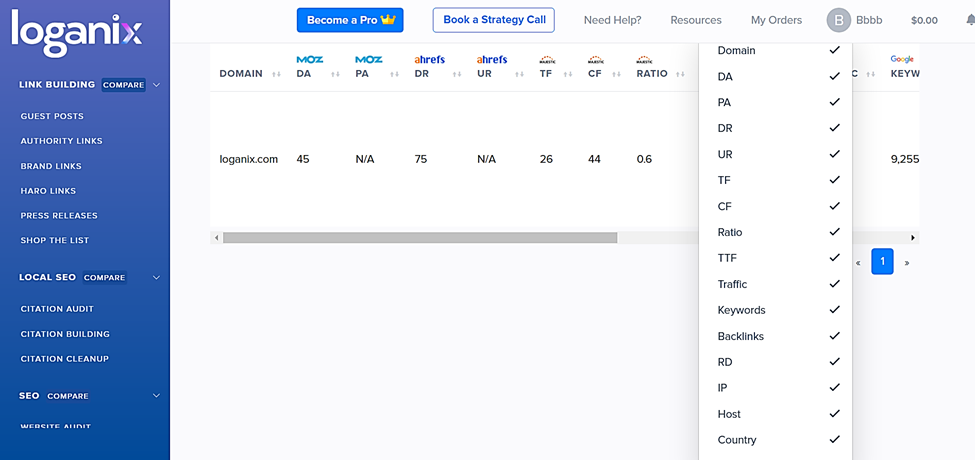
Loganix DA Checker. Source: Loganix
Then get this. The Loganix DA Checker offers all these capabilities for free. Once you access its web page, you get to bulk-check up to 10 domains every 24 hours without paying a dime.
The process is as simple as:
- Entering the domains of the pages that you’d like to analyze into its text field.
- Reviewing and confirming that you’ve typed only one URL per line.
- Clicking on the captcha checkbox.
- Specifying your email address.
- Hitting the “Lookup” button.
That’s all it takes and you’ll find the results on your Loganix dashboard.
2. Ahrefs Website Authority Checker
As the mother of the Domain Rating concept, Ahrefs is undeniably the best platform for running DR checks.
Within its impressive set of SEO tools, you’ll find one by the name “Website Authority Checker”. It comes in the form of a simple cloud-based system that is powered by a machine learning engine and a data-rich index.
These components work together to assess all the critical SEO metrics and subsequently generate your requested Domain Rating score in milliseconds.
So, make no mistake about it. Although it’s christened “Website Authority Checker”, this tool is not a DA checker. Its forte is Domain Ratings.
And to use it, you need to:
- Access the Ahrefs Website Authority Checker web page.
- Enter the subject domain or URL into the primary text field.
- Proceed with the captcha verification.
- Click on the “Check Website Authority” button.
The system will immediately display a pop-up window that shows the site’s Domain Rating score, along with the total number of backlinks and linking websites.
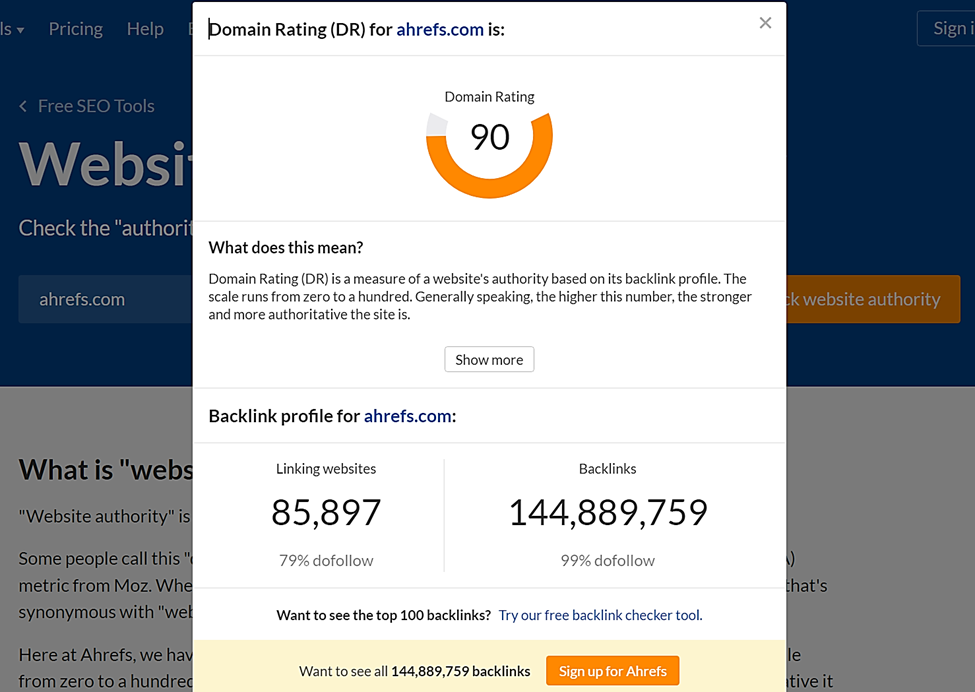
Checking Domain Rating with Ahrefs Website Authority Checker. Source: Ahrefs
What’s more, you also get to confirm the ratio of the dofollow attributes to the overall count of linking websites and backlinks.
Sadly, that’s as far as the tool goes at this level. For specifics about the top 100 backlinks and referring domains, you could turn to the equally simple Ahrefs Backlink Checker. Then to see all the backlinks, you’ll have to sign up for the Ahrefs platform and pay for membership.
3. Moz Domain SEO Analysis Tool
Just as Ahrefs is the master of Domain Rating checks, Moz is the undisputed king of all Domain Authority matters. This is where you go when you need an absolute confirmation of a site’s Domain Authority score.
That said, the tool to use goes by the name “Free Domain SEO Analysis Tool”. You’ll find it on Moz’s main site, from where you should be able to seamlessly generate your DA score and some basic SEO insights without any form of registration.
The system here is as straightforward as they come. You can check your DA metric by following these quick steps::
- Go to the “Free Domain SEO Analysis Tool” web page on Moz.
- Type your domain of interest into the text field.
- Hit the “Analyze Domain” button.
In milliseconds, you’ll get your results right on the same page.
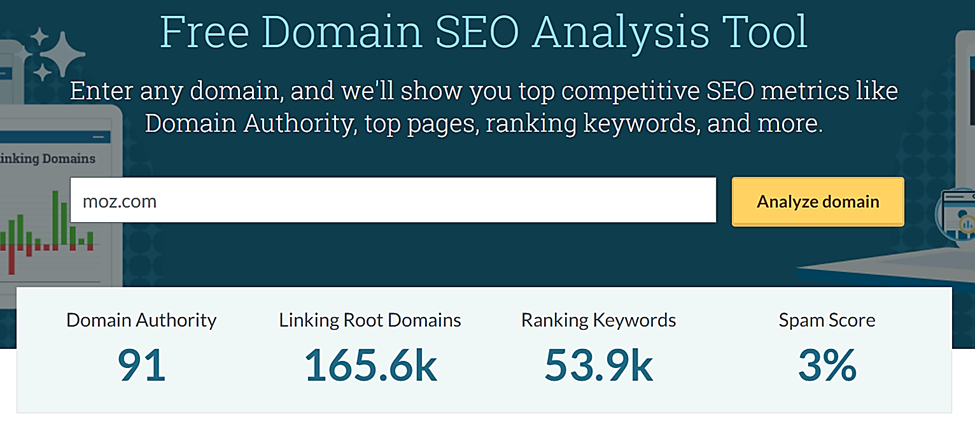
Checking Domain Authority with Moz’s Free Domain SEO Analysis Tool. Source: Moz
Moz headlines the report with not only the Domain Authority score, but also the total number of linking root domains, the total volume of ranking keywords, as well as the percentage of spammy links.
Then as you scroll further, you get to discover:
- The top seven linking domains.
- The top seven web pages by links.
- The number of new and lost linking domains per day over the past two months.
- The top seven ranking keywords.
- The top seven keywords by estimated clicks.
- The top seven branded keywords by volume.
- The top seven featured snippets.
- Keyword ranking distribution trends.
- The top seven search competitors.
- The top seven search questions with relevant keywords.
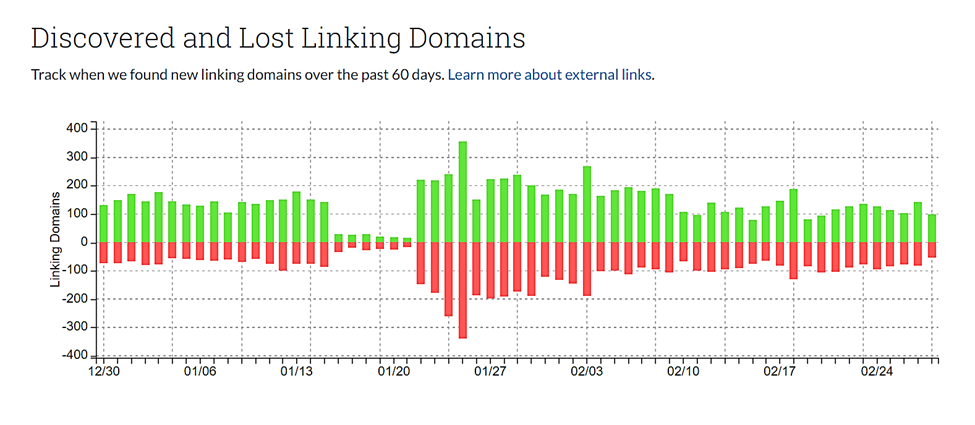
Additional metrics as provided by Moz.
Just what you need to kickstart your link-building campaign, refine the SEO keywords, and maybe track your SEO performance in comparison to your top competitors. Moz even allows you to leverage the tool for as long as you want without paying a dime.
However, to take things to the next level, you’ll be required to register for “Moz Pro” – a premium version of the tool suite.
This will grant you access to more in-depth details that you could strategically use to audit your website’s SEO, identify high-value SEO opportunities, track all the relevant keyword rankings, and launch powerful SEO campaigns against your competitors.
DR vs DA (Summary)
Domain Authority (DA) and Domain Rating (DR) are two of the most prominent metrics that SEO experts use.
But you need to keep this in mind: these scores come from third-party SEO tools.

Take SEMrush and Ahrefs, for instance. You might have noticed that while SEMrush assigns its web pages a Domain Authority score, Ahrefs prefers to go with Domain Rating.
Now, this is where the whole Domain Rating vs Domain Authority confusion comes in.
You see, if you compare your page performance indicators across SEMrush and Ahrefs, you’ll ultimately realize that Domain Rating is not directly interchangeable with Domain Authority. Although they happen to share some similarities, there’s a noticeable difference between the two terms.
And the drama doesn’t end there. As it turns out, neither Domain Authority nor Domain Ranking is factored in by the Google ranking algorithm…
… but that’s a blog post for another day.
Hand off the toughest tasks in SEO, PPC, and content without compromising quality
Explore ServicesWritten by Aaron Haynes on December 2, 2022
CEO and partner at Loganix, I believe in taking what you do best and sharing it with the world in the most transparent and powerful way possible. If I am not running the business, I am neck deep in client SEO.





